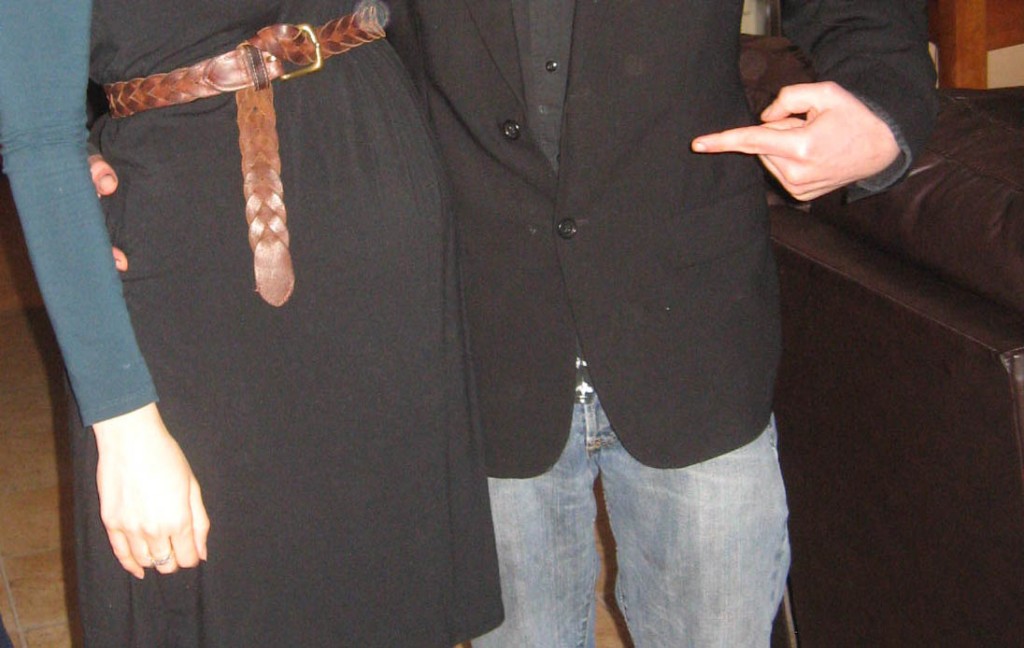We were a battalion of weebles accompanied by hovering guards, and we invaded the 11th floor of Roosevelt Hospital not too long ago. “You may hear some weird noises,” our guide said. “There are some women in labor right now.”
Couple by couple we checked out the maternity ward: the modern Labor, Delivery & Recovery (LDR), on one floor, and the Birthing Center, the natural-birth alternative on the 11th. Dr. Awesome and I filed into one after another birthing center room, all of them nearly identical. Each was like a roomy hotel suite with a full-size bed, a small jacuzzi, a few chairs, a TV, natural wood furniture—even a lovely view of the Hudson River.
“Wow, this is really nice,” I said to Dr. Awesome. “Now can we just add drugs?”
Choosing how to give birth is a decision fraught with more complications than you would imagine. For most of history, of course, it wasn’t an issue. You got knocked up, you realized it after a few months, and several months after that you got on with it. A good portion of the time you lived and the baby lived, but frequently enough one or both of you died.
Now—at least for a woman like me, with health insurance, living in NYC—there are lots of options.
What’s interesting is the hand-wringing and moral-wrangling now attached to how one gives birth. Yes, modern human females have been giving birth vaginally, largely without pain relief, for at least 160,000 years. But that doesn’t mean they haven’t tried; various potions and remedies—many of which, like hemlock, are seriously poisonous—have been used by cultures all over the world throughout history to attempt to relieve the pain of labor.
There are lots of other natural events requiring some medical assistance that aren’t yoked by morality. Skulls have been found dating to the Stone Age that show clear evidence of trepanation—the cutting of a hole in the skull to relieve pressure on a swelling brain (or, perhaps, to release malevolent spirits—who knows the motivation, but the effect on the brain was the same). Would anyone today expect you to have a section of your skull cut out without anaesthesia purely because it had been done that way in the past? Or to have a tooth removed without even the minor relief of Novacaine?
Of course, pregnancy is not a disease; in fact, its treatment as a weird malady of the lady parts by male doctors during the past several hundred years, particularly in Europe and America, is one of the main reasons so many women today are reflexively suspicious of the “medicalized” birth. For sheer physics alone, lying on your back in labor—a position that does nothing but give birth attendants a better view—makes no sense: gravity can’t help, and there’s nothing to push against. Rushing the process of labor can lead to (oh god stop my brain from even thinking about it) episiotomies and increased cesarian births. Epidurals can slow down labor and make it difficult for a woman to know when to push.
As recently as the 1950s, laboring women in the U.S. were given general anaesthesia; while they were under, the baby was simply removed like any other excessive growth—like a tumor. Countless women (and their frustrated partners) tell horror stories about feeling helpless as they were shunted around the maternity ward like pieces of howling meat, with little attention paid to their preferences for labor or the level of medical intervention they want. We are all scared shitless by the endless images of laboring women in movies and TV screaming their heads off—while lying down, of course. For years, every time I’ve seen some scene of labor, I’ve crossed my legs and squeeeeezed hard. Because the message is: Labor is trauma. It is pain. It is terror and emergency and the unknown. And only by having the experience tightly controlled by the professionals can you and the baby get through it.
But there is also a romanticizing of childbirth by many natural-birth advocates that is equally not based in reality. First of all, let’s take this concept of “natural.” Here are some perfectly natural elements of the world: Cancer. Cavities. Getting eaten by something faster and stronger than you. Flesh-eating bacteria, macular degeneration, fungus, great white sharks. And, of course, dying in childbirth.
Mother nature has been picking us off during childbirth for forever. It’s a risky proposition for many women and babies around the world even today, from those suffering from malnutrition and disease to girls who give birth too young, before their pelvises have fully developed—often as a result of stunted growth from said malnutrition or disease. There’s a veritable epidemic in Africa of teenage girls who get fistulas during labor. Their bodies literally rip open with holes. Afterward they suffer from constant incontinence and are then shunned by their husbands and communities.
The operation to fix a fistula costs about $450, by the way. You can donate here.
Fistulas used to be common enough in developed countries even in the 19th century, and it was doubtless common across the world for millennia. And that’s one of the better examples of what can go wrong in childbirth, because at least both mother and child live. You want a macho pregnancy? Try undergoing a cesarian birth without anaesthesia, which also has happened throughout history. (Though the story that Julius Caesar himself was delivered by this method is surely apocryphal.)
The idea that if those evil men hadn’t gotten involved in pregnancy (beyond conception), then every birth would be a profound, if difficult, experience bathed in a golden glow of Natural, is doubtful.
And keep in mind that in Judeo-Christian cultures, the idea that women are being continually punished for Eve’s transgression in the Garden of Eden is a durable thread that persists to this day. If you’re all down with natural womanhood and against the patriarchy, make sure you’re not falling into the trap of thinking that fate of woman is to suffer, and that in fact you must suffer if you’re going to be a good mother—labor being your first test.
My goal has been to find some sort of middle ground between the two extremes—the pregnancy-as-disease mindset, and the strangely macho Mother Earth birth.
I had to make some kind of decision while I was still in the single-digit weeks of pregnancy, when the idea of this person growing inside me, let alone the idea of giving birth to said person, was still utterly surreal. I had no idea how I might feel about labor come the Big Day, but I knew I wanted to leave my options open.
For that reason, I chose an obstetrician who has midwives on staff, and a hospital that has both a natural birthing center and a standard hospital LDR ward. (Incidentally, and hilariously, in the pamphlets Roosevelt Hospital hands out to expectant parents, giving birth in the LDR ward is called having “the traditional birth experience.” So I’ll be squatting in a mud hut while the nurse hooks me up to a fetal monitor, right?)
I knew a few things. First of all, I wanted to give birth in a way that made sense. A strange criterion, maybe, but there it is. No help from gravity and pushing against nothing make no sense. An inability to switch labor positions makes no sense. Neither does it make sense to needlessly suffer from pain just to prove I’m a hard ass. (I know I’m a hard ass. C’mere so I can punch you!)
Secondly, I knew that I like drugs. Drugs are my friend! I’m not a crazy pill popper—I rarely take even cold medicine or Tylenol—but the drugs that I’ve come to know and love I, well, know and love. Give me a Xanax on an intercontinental flight. Let me pop an Ambien when insomnia has me near insane with unsatisfied exhaustion.
Lastly, I wanted to participate in the birth, neither so doped up I can’t feel anything nor so frantic with pain that I’d plead with someone to knock me out with a hammer just to put me out of my misery.
Is there a way to have pain relief and yet some mobility? Is there a way to have an experience couched by a) the safety and security of a modern medical facility and b) patience and assurance from someone who knows that, despite the rocky record, this is indeed a process for which my body is not particularly well designed (thanks, no-master-plan evolution!) but that it mostly can handle?
There may be. Roosevelt gives something called a “walking epidural,” which is essentially a lower dose of anaesthesia; it will provide pain relief but may—the midwife was a bit doubtful—allow me to switch positions in bed; I plan to do my squatting above the floor of the mud hut, thanks. Right now the plan is to deliver in the LDR area, attended by the midwife I’ve been seeing for months (I’ve only seen the obstetrician once). I may enter the ward hollering for drugs, or I may not. Who knows. I do know, though, that I’m going to do whatever feels right at the time.
On April 23, Dr. Awesome and I begin a five-week childbirth education class. Think cring-inducing birth films and breathing techniques. The class I chose offers pain-coping methods, some of which are already going to be familiar to me from yoga and meditation, but it also fully covers pain-relief options, i.e. drugs.
Whatever happens, I’m sure that the experience will turn out to be much as Dr. Awesome predicted after we wrapped up the maternity-ward tour. As we walked back to Columbus Circle to catch the A train, he dragged on his cigarette and said, “Everytime we went into a new room I thought, ‘Is this where I’m going to get my mind fucking blown? Or is this? Or is this?‘”


